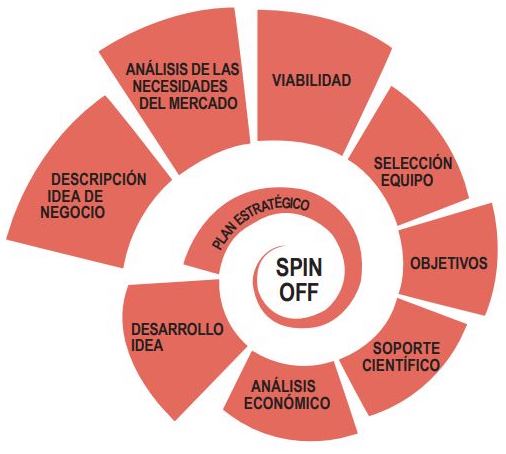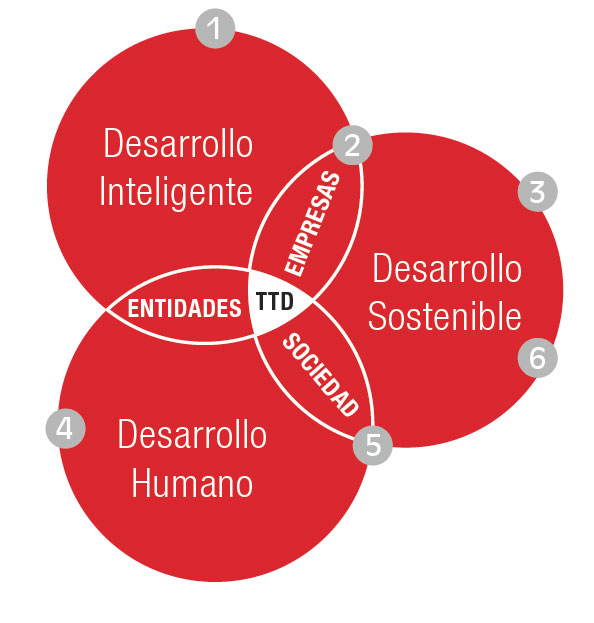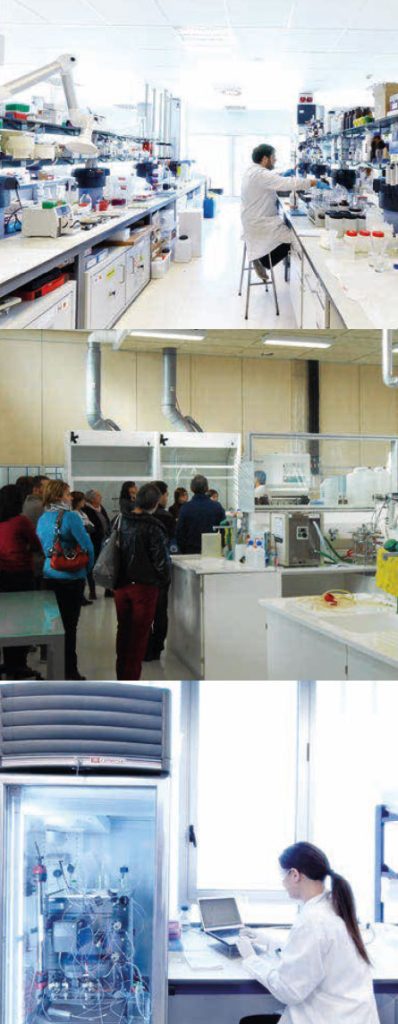TECHNICAL SKILLS AND MATERIAL CHARACTERISATION
Leitat, thanks to its multisectoral commitment, is fully aware of the need for constant upgrades in order to use the latest technological equipment and to engage in the characterisation and behaviour of materials, aimed at a wide range of industries.
DETERMINATION OF PHYSICAL-MECHANICAL PROPERTIES
- Traction, flexion, compression, peeling, coefficient of friction, adhesion, Drilling, and others
- Abrasion, wear, scratching, and surface hardness
- Colour fastness, wash resistance, and comfort
- Impact Resistance
- Rheometry (MFI/MVR) and viscosity
- Density of liquids and solids
- Water permeability, vapour resistance, liquid absorption, and others
- Electrostatic charges
- Tribología
DETERMINATION OF CHEMICAL PROPERTIES AND EMISSIONS:
- Identification and characterisation of polymers and additives: FT-IR, DSC, TGA, UV-Vis, and others
- Molecular weight (GPC)
- Gas (GC-MS, GC-FID) and liquid chromatography (HPLC)
- Inductively coupled plasma mass spectrometry (ICP-MS)
- Analysis of nanoparticles and encapsulated products
- Elemental analysis (EA)
- Identification and characterisation of volatile and residual substances (VOCs, formaldehyde and others)
- Carbon and formaldehyde emissions (automotive)
- Condensable fogging components (automotive)
- Phthalate analysis
EU-Ecolabel
Tests and evaluation of environmental criteria for all categories. For example:
- Textile products
- Surface cleaning products
- Laundry detergents
- Laundry detergents for industrial and institutional use
- Dishwasher detergents
- Dishwasher detergents for industrial and institutional use
- Hand-washing detergents
- Cosmetics (which require rinsing)
- Paint and varnishes
- Furniture
- Lubricants
- Paper
- Tourist accommodation
- Camping sites
ENVIRONMENT
- Waste water analysis. (DQO, BOD5, NTK, SSD, SSV, Hardness, etc.)
- Analysis of anions and volatile fatty acids
- Analysis of metals in soil and water
- Analysis of emerging contaminants
- Biodegradability tests
- Analysis of biogas
- Analysis of air pollutants
- Analysis of fertilisers (NPK)
FOOD
- Analysis of fatty acids (GC-FID)
- Analysis of proteins
- Analysis of total polyphenols and antioxidant power
- Analysis of total protein
- Analysis of fibres
- Analysis of sugars
- Analysis of metals (Hg, As, Cr, etc.)
PROTECTION - Gloves and Clothing
- Resistance to cut, impact and impact abrasion
- High Visibility
- Mechanical, thermal, chemical and microorganism risks
- Motorcycling, welders, firefighters, forestry and others
- Protective clothing comfort
VALIDATION OF PROTOTYPES
- Materials
- Finished products
- Industrial processes
APPLICATION OF NEW TECHNOLOGIES
- Plasma
- Polymer extrusion
- Rapid prototyping - 3D printing three-dimensional metrology (in laboratory)
- Metrology of parts; approval reports of moulds and dyes
- Measurement and graphical reports with comparative CAD method
- Dimensional study for analysis of assembly problems
- Measurement of samples and statistical studies of process control
- Automatic measurement software for coordinate measuring machines
- Digitisation and reverse engineering
REACTION TO FIRE:
- Tests for materials intended for upholstery and curtains
- Materials for tents and textile architecture
- Fire safety of aviation textile and polymeric products
- Fluid tests (Manifold, Wick test)
- Horizontal combustibility tests for automotive interior products
BIOANALYSIS AND HEALTHCARE
- Antibacterial and antifungal activity of active principles, materials and formulations
- Models of formation and elimination of biofilms
- Microtoxicity studies and microbiological control of water
- Tests for enzyme activity
- Safety and efficacy studies for cosmetics
- Efficacy test for preservatives in cosmetics (Challenge Test)
- Safety studies for detergents
- Safety studies for medical devices
- Bioavailability and food allergenicity studies
- Drug absorption, distribution, metabolism, excretion and toxicity studies (ADME-Tox)
- Bioequivalences
- In vitro/in vivo metabolomic analysis
- Efficacy studies for anti-tumour compounds (in vitro and in vivo)
- Efficacy studies for potential drugs against autoimmune and inflammatory diseases (in vitro and in vivo)
- Generation of polyclonal and monoclonal antibodies for research, diagnosis, prognosis and therapy
- Design and development of diagnostic biosensors
- Antibody engineering: humanisation and chimerisation; nanobodies, scFv, bispecifics, ADCs, fusion proteins, biosimilars
- Drug reprofiling
LEITAT CREATES
Entrepreneurship
Creation, development, and technology transfer with social engagement in new markets, based on needs identified in markets and industries. Financial and competitive support for the development of the projects/products for a guaranteed impact on the market while capitalising on technological development.
Tech Mentoring
Technology transfer from knowledge-generating cores to the market. Intensive use of technology and knowledge obtained through research. Creation of assets and capacities for clients (technology, brand and systems).
Advanced Management
Strategic management focused on the global market. Management skills and abilities. Flexibility and adaptability.
Growing Business Area
Access to multisectoral teams, leveraging synergies with the Centre in an open innovation environment to expand the scope of initiatives. Accelerator platform for international expansion. Complementarity with other existing projects.
FFF Community
Relationship with funds and financial partners to facilitate and improve business plans and the initial stages of Technology-Based Business (EBT) projects. Generation of critical mass for business development, promoting and developing projects to support growth and business consolidation oriented to market success.
LEITAT INNOVATES
ConceptLab
Definition of genuine and market-oriented product, service, process and business model concepts.
Re-targeting
Search for new business activities that sustainably provide companies with competitive advantage.
Information technology
Improvement of the technological level of products, services and processes. Provision of tools to discover, evaluate and transfer external technological knowledge.
Training and transfer
Design of generic and specific training on technological issues and innovation management.
Innovation management
Implementation of a custom model to improve innovation capacity.
Process improvement systems:
Process improvement, using more efficient management techniques and models.

LEITAT INNOVA
Where have we come from?
INDUSTRIA 1.0
1784 - FIRST MECHANICAL LOOM
Application of mechanisation. Driven by water and steam energy.
INDUSTRIA 2.0
1870 - FIRST CONVEYOR BELT
Mass Production. Division of labour. Electricity application.
INDUSTRIA 3.0
1969 - First programable logic controller
Use of electronics and computing to promote automated production.
INDUSTRIA 4.0
TODAY
Hybridisation of physical and cybernetic systems. Technology 4.0
INDUSTRIA 5.0
TODAY
Social objectives. Beyond jobs and growth. Resilient provider of prosperity. Respect for the limits of the planet. Welfare of the worker central to production.
Technological development has served to bring out innovation and for society to benefit, historically seeking greater well-being and growth.
Where are we?

In order to complete the paradigm of industrial technology as a source of innovation and well-being, it is necessary to ensure that it respects the limits of the planet, generates adaptable and resilient models, and that it places human well-being at the center of production processes.
Where are we going?
MAIN TECHNOLOGICAL AREAS OF ACTION
TTD: Technological and digital transformation
DIGITAL AND HYPERCONNECTED WORLD
- Artificial intelligence
- Internet of Things
- Wearables
- Printed electronics
- Sensors, biosensors and actuators
- Photonics
INDUSTRY 4.0
- Additive manufacturing and 3D printing
- Advanced manufacturing processes
- Robotics & Automation
- Eco-sustainable production
- Intelligent Metal Working Fluids
- Green Composites
GREEN ENERGY
- Energy conversion and storage
- Low carbon energy generation
- Integration of energy devices and systems
- Sustainable mobility
- Smart inks
- Nanomaterials for batteries

HEALTH AND PERSONALISED MEDICINE
- Diagnosis and personalised therapy
- Oncology and angiogenesis
- Regenerative medicine
- Biosensors and nanosecurity
- Skin health and cosmetics
- Biological drugs and improvement of therapeutic efficiency of drugs
- Nutrition and food science
- Biocompatible materials
URBAN HABITAT
- Smart Infrastructure
- Nano and eco-efficient biomaterials
- Healthy and comfortable cities
- Road safety
- Construction technologies
- Smart coatings
CLIMATE CHANGE & RESOURCE SCARCITY
- Prevention of pollution of marine and terrestrial ecosystems
- Bioresources and agri-food technologies
- Biotechnology and bioeconomy
- Waste treatment and recovery
- Compostable polymers and biopolymers
- Biocomposites with natural fibres
How do we do it?
R+D+2i Projects
Laboratory tests and certifications
Incubation services
Technological centre of excellence
Spin-off & IPR
The field of technology is changing and will continue to do so, as well as posing present and future changes and challenges. However, it is not alone in this. We are moving towards transforming industry into having a beneficial evolutionary impact on society. The real aim of this new industry includes social and environmental considerations. We are moving towards responsible innovation that contributes to increasing the prosperity of all the players involved: businesses, society and the environment.

